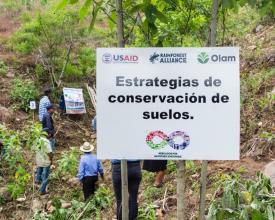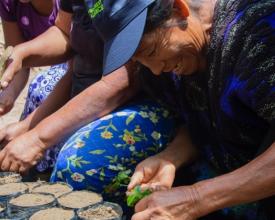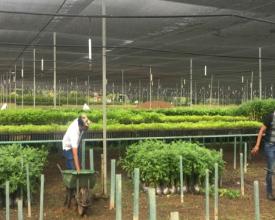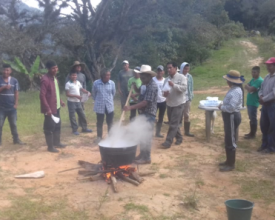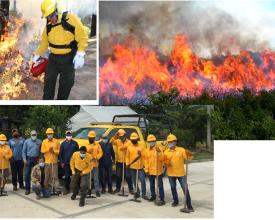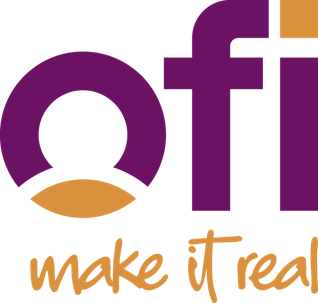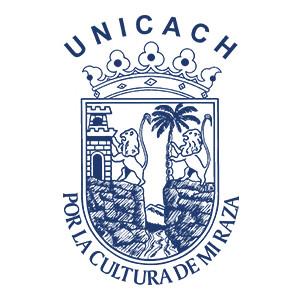
Regeneration of degraded plots to coffee plantations under native shade trees.
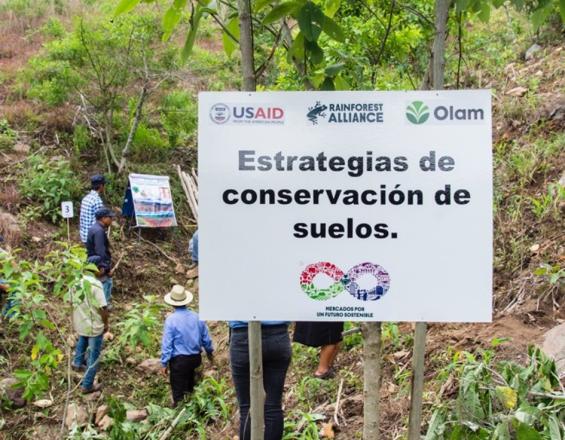
The coffee-growing landscape of the Frailesca region is facing climate change and overexploitation of natural resources. With the intervention of the Alianza por los Paisajes Sostenibles y Mercados (APSyM) project and the participation of strategic allies, forest cover was regenerated on nearly 110 ha in 8 localities, generating economic benefits for coffee growing families and favoring the permanence of environmental services, which are fundamental for the well-being/economy of coffee growing families.The project strengthened the capacities of coffee growers to reforest degraded areas and apply Climate Smart Agriculture techniques, such as 1) building living barriers of trunks/branches to retain soil and moisture, 2) integrated pest/disease management with mineral broths, pheromone traps for the coffee berry borer and spraying fungal spores(Trichoderma) to control coffee rust, and 3) planting in contour lines.
Context
Challenges addressed
- Degraded areas due to overexploitation by agriculture and/or livestock;
- Opening of wooded areas for shade coffee production;
- Climate change (increase in extreme weather events);
- Communities isolated from more economically developed towns;
- Roads that require four-wheel drive vehicles;
- People who do not have easy access to material inputs;
- Lack of knowledge of productive techniques in agroforestry systems;
- Lack of attention to factors other than production.
Location
Process
Summary of the process
It is necessary to have a central project that has the resources for the technicians to constantly visit the people who produce, in order to promote the implementation of techniques to improve the quantity and quality of coffee, which have a direct impact on the immediate economic income, as well as to resolve doubts, manage other support, interactions and participation with other institutions to ensure that they contribute to the main project. Training in environmental care and restoration tends to be the most difficult activities to promote, but when combined with a personal commitment to improve the present and be able to provide a better future for their children and the community in general, they are applied by the people who produce. The implementation of these actions has as a reward some support that is managed by the Oro Verde-ofi organization, as well as the attention to their needs or problems different from those of the central idea of the project, such as those related to fire management, improvement of family nutrition, better post-harvest techniques for corn, among others.
Building Blocks
Training in landscape regeneration techniques
The coffee-growing landscape of the Frailesca region is facing adverse factors such as climate change and overexploitation of natural resources. For this reason, training was provided to adapt production schemes to halt and reverse the degradation/loss of natural resources. Awareness-raising workshops and landscape restoration practices were carried out in 8 localities, with groups of 20-25 people. An exchange of experiences between coffee growers was also carried out, which consisted of visiting localities with sustainable production practices to show the management of a coffee plot with landscape restoration actions, which showed the participants that with the appropriate technical support, it is possible to improve environmental conditions (lower temperature and nutrient/humidity retention), the yield of fruit per plant and the quality of the coffee.The visit to specialized research centers and the transfer of technologies (demonstration plot) served to show how knowledge is generated to improve crops, applying landscape regeneration techniques with Climate Smart Agriculture, and the importance of sharing it with the people who produce.
Enabling factors
- Conduct a participatory training needs assessment to identify common issues;
- Involve technicians with skills to facilitate training workshops;
- Have a system in place to track training, attendees and implementation of restoration techniques to provide additional support to those who are lagging behind;
- Monitor implementation of restoration knowledge and skills learned;
- Procure in-kind incentives to reinforce the implementation of restoration actions.
Lesson learned
The training should have several didactic resources, not only the speech or slides, since the participants learn by observing and doing, which allows the appropriation of the restoration techniques and favors their implementation in the future. An atmosphere of trust should also be generated, outside the formality of the training, with diverse topics that even seem unimportant, so that participants can have the confidence to ask questions and mention some of the daily problems that afflict them. The exchange of experiences with producers in other localities or regions that have implemented restoration measures allows them to show examples of what they are trying to do in new producer communities. These visits allow them to talk directly with the people who implement them to learn about the tangible benefits.
Training in intensive sustainable coffee production
Increasing the quantity/quality of coffee increases the income of producers, which motivates them to train in intensive sustainable coffee production. The training included the management of fabrics to increase the production/quality of coffee, elaboration of inputs for integrated pest/disease management, improvement of the nutrition of the coffee plants with soil fertilization, and the application of foliar products that promote consistent development and improve their capacity to adapt to adverse climatic conditions (drought, increased sunlight), as well as to better resist attacks by pests and diseases. This resulted in higher flowering and better fruit set, with yields well above the regional average, going from 8-10 quintals of parchment coffee/ha to 18-25 quintals/ha in 4 years. These high average production levels have motivated producers to renovate coffee plantations damaged by coffee rust, as well as to plant coffee trees in places where corn and beans were planted or where pastures were used for cattle grazing. The benefits of the aforementioned practices are very visible, since the communities went from having one or two vehicles to having around 15-20, with which they use to move their harvest.
Enabling factors
- To have trained instructors with specialized experience in intensive sustainable coffee production;
- Consider local conditions in the techniques to be implemented; the success of a technique that has not been validated cannot be guaranteed;
- Use low investment technologies and affordable inputs in the region;
- Use a demonstration plot, where the technologies to be internalized in the practices of the producers are put into practice.
Lesson learned
- The use of visual support in training facilitates access to information and knowledge among the people who produce.
- The best technique to internalize knowledge is "learning by doing". If it is about reasoning or mental processes of analysis, the description of the process or expected result must be correctly expressed.
- Giving summaries that concretely show the procedures to be replicated makes it easier for people who could not take notes to repeat the activity later.
- Applying the techniques to increase production in a demonstration plot helps people to see the response of the plants that have received the correct application of sustainable intensive production techniques.
- Allowing experimentation for producers to test their theories is healthy, it shows them that there is an openness to try other ways of how to achieve the same result, and it motivates minds to decipher the elements that make up success.
Attention to problems that afflict the people who produce
Often, a project has objectives and activities defined at the beginning of its implementation in the field; however, interactions with the people who produce reveal other needs, problems and relationships that were not visible to the naked eye and that can become limitations to achieving the fundamental objectives of the initiative. For this reason, it was necessary to dedicate time to listen to the people who produce, accompany them to the places where they travel, support them in carrying out various activities in their daily lives and talk with them. This made it possible to identify specific problems and allied institutions that could contribute to addressing them, such as vulnerability to forest fires, the deterioration of the families' health due to poor nutrition (the result of their low purchasing power and lack of knowledge of how to take advantage of local ingredients). In addition, needs were identified to respond with first aid to accidents at work and in the families' daily lives.
Enabling factors
- Allocate time to socialize with the population to build trust, respecting the uses and customs of their culture;
- Strengthen the management capacities of community leaders so that they have the skills to meet their needs;
- Establish alliances with institutions to address some of the needs identified by the local population;
- Establish a relationship of trust with coffee growers, maintaining mutual respect, allowing them to share their expectations and needs different from those related to production and the environment.
Lesson learned
The approach to municipal authorities to present the APSyM project made it possible to map the actors involved in the implementation territory. In this case, the municipalities of Villa Corzo and Villaflores were visited. The governments of the three levels coordinate in different spaces to plan, evaluate and decide on the implementation of plans and programs in the territory, so it was very useful to participate in these spaces to offer technical assistance and to request support in specialized topics. We also participated in the modification of local regulations that serve the interests of the people participating in the project.
Impacts
- Reconversion of 110 ha of degraded land to productive agroforestry systems. The producers installed around 100 trees/ha on the margins and in areas of importance for soil retention. The converted plots now support about 3,300 rust-tolerant coffee bushes, in addition to other native and fruit tree and shrub species, which provide food for families and local fauna, mainly birds, that have been seen returning to these wooded areas;
- The family economy has improved with the implementation of a production system that includes careful management of pruning, fertilization and integrated pest management, managing in some cases to increase yields from 10 to 18 quintals, and in some cases to 25 quintals, of parchment coffee per hectare in four years;
- Management of local alliances that made it possible to address needs other than productive ones, such as the nutritional status of families or to develop as community brigades to prevent and combat forest fires.
Beneficiaries
Coffee growers who participated in training sessions, totaling 3,305 attendances in 4 years of accompaniment, as well as the population of the lower part of the micro-watershed, who take advantage of the benefit of rain infiltration.
Sustainable Development Goals
Story
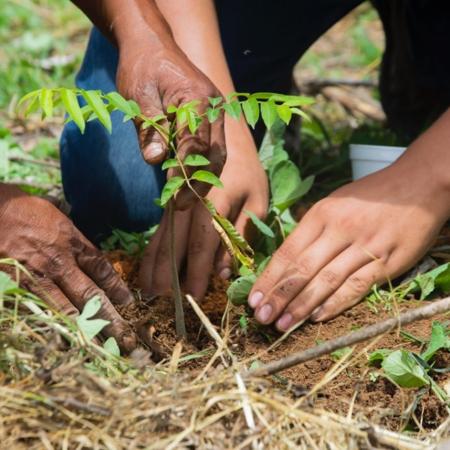
Mr. Diego Gómez's family lived through the experience of seeing his father go to the northern states to look for work to provide for his family. In the meantime, his wife and children, with the support of his siblings, planted 75 shade trees and 833 coffee trees on ¼ ha of pasture, which produced pasture of very low nutritional quality for cattle. The trees were donated to the Gómez family by the APSyM project. When the coffee plants started production three years after planting, the Gómez family was able to make a good profit, because the price was around MX$60/kg of parchment coffee. This fair price was paid by the ofi company in recognition of the quality of the coffee, since other local buyers use the Bolsa price as a reference to discount defects, such as broken, broccolored, wet, stained beans, among others, but not to pay a better price for quality. In addition, ofi offered and kept his promise to provide technical assistance and manage other in-kind support, such as drying patios, solar dryers, pulpers, among other benefits. As a result, Don Diego decided to return to work in the new coffee plantation. Today, the Gómez family continues to prosper in coffee production, because they are implementing the knowledge acquired in the training workshops given by the APSyM project, such as 1) planting coffee trees in contour lines on slopes, 2) pruning and production of coffee trees, 3) planting and maintenance of native shade trees, among other topics. The Gómez family arrived in 2007 and found the site deforested by immoderate logging, extensive cattle ranching and corn monoculture promoted by previous owners, which accelerated the degradation process. However, this trend was reversed with the reforestation carried out with native species and the planting of coffee trees in contour lines that retain and improve the soil, allowing them to enjoy a fresher environment and a landscape that they are proud of, very different from the one they found when they arrived. This case is a good example for other families that are thinking of leaving their locality to look for additional income in the north of the country, to reconsider staying.

